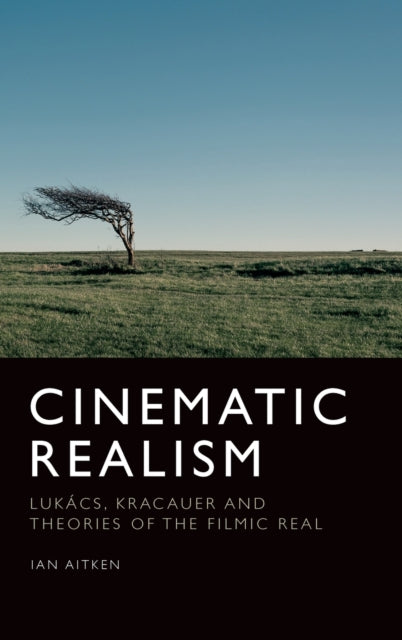Ian Aitken
Cinematic Realism: Lukas, Kracauer and Theories of the Filmic Real
Cinematic Realism: Lukas, Kracauer and Theories of the Filmic Real
YOU SAVE £22.65
- Condition: Brand new
- UK Delivery times: Usually arrives within 2 - 3 working days
- UK Shipping: Fee starts at £2.39. Subject to product weight & dimension
Bulk ordering. Want 15 or more copies? Get a personalised quote and bigger discounts. Learn more about bulk orders.
Couldn't load pickup availability
- More about Cinematic Realism: Lukas, Kracauer and Theories of the Filmic Real
Cinematic realism is important because it explores the relationship between representation and reality, and how different theories of realism have sought to understand film's relation to reality. Ian Aitken's book links the issue to human experience and analyzes the close similarity between the film image and visual perception.
Format: Hardback
Length: 256 pages
Publication date: 31 October 2020
Publisher: Edinburgh University Press
Cinematic realism is a significant issue that explores the relationship between representation and reality in film. It raises the question of whether certain forms of representation are closer to reality than others and how this understanding can be applied to filmic representation. In his book, "Cinematic Realism," Ian Aitken delves into this topic, examining the close similarity between the film image and visual perception and the various theories of realism that have sought to uncover the nature of film's relationship with reality. Aitken focuses on the writings of Georg Lukcs and Siegfried Kracauer, providing a comprehensive exploration of cinematic realist theory.
One of the key aspects of cinematic realism is the idea of the film image as a representation of reality. Aitken argues that the film image is not a direct copy of reality but rather a constructed representation that is shaped by the filmmaker's artistic choices and the viewer's interpretation. This means that the film image can be interpreted in multiple ways, depending on the viewer's perspective and cultural background.
Aitken also explores the different theories of realism that have been developed over time. He discusses the realist tradition, which emphasizes the importance of representing reality accurately and objectively, and the modernist tradition, which emphasizes the use of artistic techniques to create a sense of reality. He also discusses the postmodernist tradition, which challenges the idea of realism and suggests that reality is a constructed illusion.
One of the challenges of cinematic realism is the issue of verisimilitude. Verisimilitude refers to the degree to which a film or other work of art appears to be real. Aitken argues that verisimilitude is not simply a matter of technical accuracy but also involves the emotional and psychological impact of the work. A film that is verisimilar can create a sense of immersion and engagement that can be difficult to achieve with other forms of art.
Aitken also discusses the role of the filmmaker in cinematic realism. He argues that the filmmaker has a responsibility to create a film that is both accurate and meaningful. This means that the filmmaker must be aware of the cultural and historical context in which the film is set and must work to create a film that is relevant to the audience.
In addition to its theoretical aspects, cinematic realism has also had a significant impact on the film industry. Aitken argues that cinematic realism has led to the development of more realistic and authentic films, which have been more successful with audiences. He also argues that cinematic realism has helped to break down the barriers between different cultures and has contributed to the development of a more globalized film industry.
However, cinematic realism has also been criticized for its limitations. One of the main criticisms is that cinematic realism can be too focused on the technical aspects of film-making and can neglect the emotional and psychological aspects of the story. Aitken argues that this can lead to a sense of detachment from the film and can make it difficult for the audience to connect with the characters.
Another criticism of cinematic realism is that it can be too limiting in terms of the types of stories that can be told. Aitken argues that cinematic realism can be used to tell a wide range of stories, but it can be difficult to create a film that is both realistic and engaging. This can lead to a sense of boredom or frustration for the audience.
In conclusion, cinematic realism is a significant issue that explores the relationship between representation and reality in film. It raises the question of whether certain forms of representation are closer to reality than others and how this understanding can be applied to filmic representation. Ian Aitken's book, "Cinematic Realism," provides a comprehensive exploration of cinematic realist theory, focusing on the writings of Georg Lukcs and Siegfried Kracauer. While cinematic realism has had a significant impact on the film industry, it has also been criticized for its limitations. It is important for filmmakers to be aware of these limitations and to work to create films that are both accurate and meaningful.
Weight: 618g
Dimension: 163 x 240 x 29 (mm)
ISBN-13: 9781474441346
This item can be found in:
UK and International shipping information
UK and International shipping information
UK Delivery and returns information:
- Delivery within 2 - 3 days when ordering in the UK.
- Shipping fee for UK customers from £2.39. Fully tracked shipping service available.
- Returns policy: Return within 30 days of receipt for full refund.
International deliveries:
Shulph Ink now ships to Australia, Belgium, Canada, France, Germany, Ireland, Italy, India, Luxembourg Saudi Arabia, Singapore, Spain, Netherlands, New Zealand, United Arab Emirates, United States of America.
- Delivery times: within 5 - 10 days for international orders.
- Shipping fee: charges vary for overseas orders. Only tracked services are available for most international orders. Some countries have untracked shipping options.
- Customs charges: If ordering to addresses outside the United Kingdom, you may or may not incur additional customs and duties fees during local delivery.


